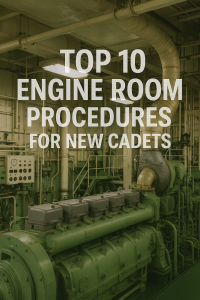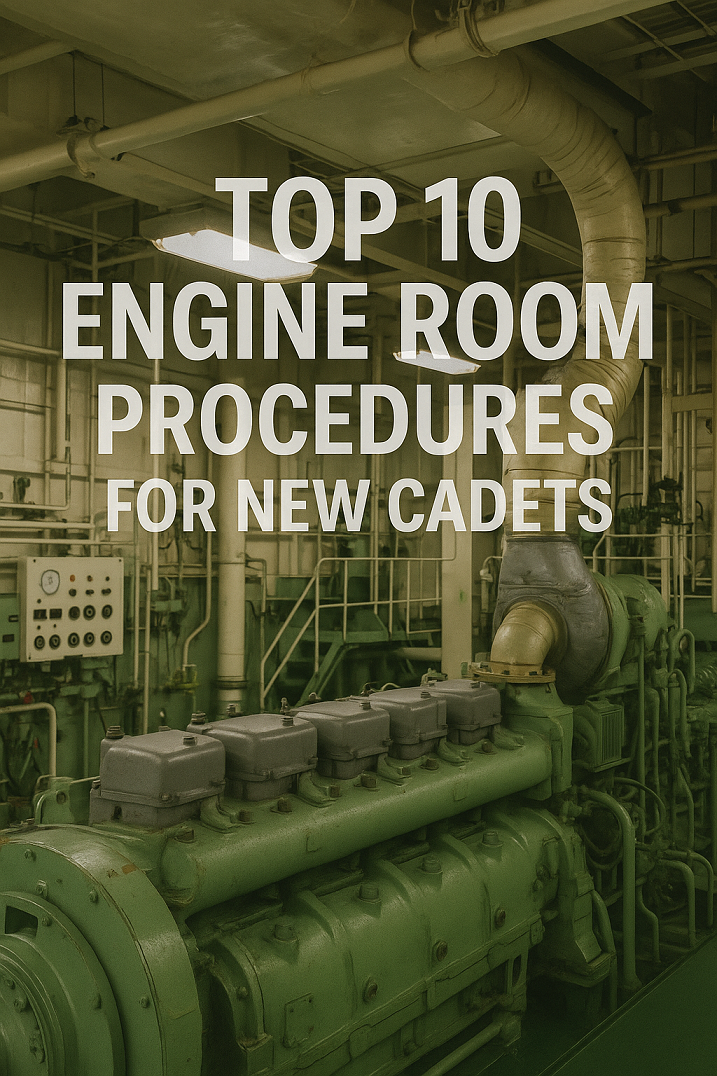Discover the top 10 engine room procedures every cadet should master. Learn how these essential practices ensure operational safety, efficiency, and career readiness in the maritime industry.
Why Engine Room Procedures Matter in Modern Maritime Operations
 For a cadet entering the world of marine engineering, the engine room can feel like a labyrinth of pipes, gauges, pumps, and unfamiliar machinery. But beneath the complexity lies a well-orchestrated system—one that drives the ship, powers its essential services, and upholds its safety.
For a cadet entering the world of marine engineering, the engine room can feel like a labyrinth of pipes, gauges, pumps, and unfamiliar machinery. But beneath the complexity lies a well-orchestrated system—one that drives the ship, powers its essential services, and upholds its safety.
At sea, the engine room is the beating heart of any vessel. Missteps in engine room operations can lead to breakdowns, energy loss, or even disasters such as flooding or fires. That’s why standard operating procedures (SOPs) are critical—especially for new cadets who must quickly learn the skills that turn theory into safe, efficient practice.
In this guide, we’ll walk through the top 10 engine room procedures every cadet should know—from morning routines to emergency drills—backed by real-world applications and IMO-aligned best practices.
–
1. Daily Engine Room Rounds and Logkeeping
Every shift starts with engine room rounds. Cadets are expected to:
-
Monitor temperatures, pressures, and fluid levels
-
Identify leaks, vibrations, or unusual noises
-
Record readings in logbooks or digital systems
Tip for Cadets:
Use a checklist and start from the bottom platform up. Note trends over days—like a slow rise in lube oil temperature—which may indicate an impending issue.
IMO Reference: STCW A-III/1 competencies in marine engineering operations
2. Starting and Stopping the Main Engine
Cadets must understand the complete sequence of:
-
Pre-start checks: cooling water, oil levels, air starting pressure
-
Warm-up process: jacking gear disengagement, remote monitoring
-
Emergency stop and shutdown procedures
Real-World Insight: Improper purging of air from the fuel system during startup can cause a failure-to-start alarm—critical during port departures.
Safety Note: Never start the engine without chief engineer authorization or a proper cooling water supply.
3. Fuel Oil System Operation and Changeover
Cadets learn how to operate the fuel transfer, booster, and purifier systems, including:
-
Handling bunker storage and settling tanks
-
Operating centrifugal separators (purifiers)
-
Performing fuel changeover before entering Emission Control Areas (ECAs)
Compliance Note: IMO MARPOL Annex VI requires fuel sulfur content below 0.10% m/m in ECAs. Timely changeover is essential.
Case Study: A delay in switching from HFO to MGO led to port state detention in a 2018 case in California.
4. Lube Oil Purifier Operation and Maintenance
Purifiers are used to clean lubricating oil and maintain machinery life. Cadets are expected to:
-
Understand gravity disc selection and throughput
-
Perform bowl cleaning and desludging
-
Record running hours for preventive maintenance
Pro Tip: Incorrect bowl assembly can cause violent vibrations. Always refer to the manufacturer’s manual before reassembly.
5. Starting and Synchronizing Generators
Keywords: generator parallel operation, shipboard electrical system
Power redundancy is vital onboard. Cadets should know how to:
-
Start standby generators (manual or auto mode)
-
Synchronize alternator output (voltage, frequency, phase sequence)
-
Load share between online generators
Safety Alert: Improper synchronization can cause reverse power trips or blackouts—a high-risk scenario during maneuvering.
IMO Compliance: STCW requires knowledge of electrical systems for watchkeeping engineers (A-III/1).
6. Bilge Pumping and Tank Sounding
Proper bilge system use prevents engine room flooding and pollution. Cadets assist with:
-
Operating bilge ejectors or pumps
-
Sounding bilge wells and drain tanks
-
Monitoring for oily water separator (OWS) bypass violations
MARPOL Note: Discharging bilge water must comply with 15 ppm limits and require automatic stopping devices.
Scenario: A cadet misidentified an oily bilge discharge valve in a real-life audit, leading to environmental non-compliance.
7. Cooling Water System Management
Cadets should learn:
-
How to backflush seawater strainers
-
Maintain correct jacket water treatment levels
-
Check for leakage and pump integrity
Pro Insight: Engine overheating is often caused by air locks or clogged strainers—simple checks can prevent engine seizure.
Use Case: Crew training videos often show how untreated cooling water leads to corrosion in cylinder liners.
8. Boiler Operation and Blowdown Procedures
Boilers provide steam for fuel heating and domestic use. Cadets assist in:
-
Fuel valve opening, firing sequence, flame monitoring
-
Low water alarm and safety valve testing
-
Performing blowdown to remove sludge and TDS
Important: Boiler explosions are among the deadliest onboard incidents. Adhering to checklists and alarms is non-negotiable.
STCW Module: Covered under A-III/1 and A-III/4 for operational engineers.
9. Emergency Generator and Fire Pump Testing
Weekly drills and checks are mandatory. Cadets participate in:
-
Manual start of the emergency generator
-
Checking auto-start circuit
-
Verifying fire line pressure and hydrant condition
SOLAS Compliance: Emergency power must be available within 45 seconds of blackout. Tests confirm compliance.
Case Example: A 2017 PSC detention cited a non-functional emergency generator due to lack of cadet awareness during inspection.
10. Safe Working Practices and Permit to Work (PTW)
Cadets are trained in risk assessment, PPE, and lockout/tagout procedures before engaging in:
-
Enclosed space entry
-
Hot work (welding, grinding)
-
Maintenance on live systems
STCW & ISM Code Requirement: All safety-critical tasks require a PTW signed by senior officers and monitored throughout execution.
Analogy: Think of PTW as the ship’s contract between trust and safety—not just paperwork.
–
Case Study: Cadet’s Role in Preventing a Blackout
In 2022, a cadet on a bulk carrier identified abnormal exhaust temperatures on one generator during rounds. Noticing increasing vibration, he immediately alerted the 2/E, who took the unit offline before a potential catastrophic failure. The chief engineer later credited this attention to routine procedures with preventing a mid-sea blackout.
FAQ: Engine Room Procedures for Cadets
Q1: Are cadets allowed to operate machinery directly?
A: No. Cadets always operate under supervision. They observe, assist, and eventually perform tasks once approved by a senior officer.
Q2: How should cadets prepare for engine room rounds?
A: Use a pre-round checklist, carry a notebook, and ask questions. Always report anomalies, even if minor.
Q3: What’s the best way to learn these procedures?
A: On-the-job exposure combined with watchkeeping duties, simulation labs, and STCW practical training is key.
Q4: Can cadets be held accountable for engine room errors?
A: Yes, to some extent. Cadets are expected to follow instructions and report hazards. Negligence or unsafe behavior can affect assessments.
Q5: Are these procedures relevant for future engineer officers?
A: Absolutely. These are the foundational practices that every second engineer and chief engineer builds upon.
Conclusion
Becoming a marine engineer begins with mastering the basics—and the engine room is where theory meets machinery, and discipline meets reality. These top 10 engine room procedures are not just tasks; they are life-saving routines and habits that every cadet must internalize.
By learning early, asking questions, and respecting the system, cadets lay the foundation for a safe, competent, and rewarding career at sea.
Call to Action: Ready to enhance your onboard competence? Download our free Engine Room Checklist & Cadet Guide at MaritimEducation.com/engine-room-training
References
-
International Maritime Organization. (2023). STCW Convention and Code. https://www.imo.org
-
ICS. (2022). Engine Room Procedures for Maritime Safety. https://www.ics-shipping.org
-
BIMCO. (2021). Watchkeeping Best Practices. https://www.bimco.org
-
UK MCA. (2023). Engineering Competency Standards. https://www.gov.uk

